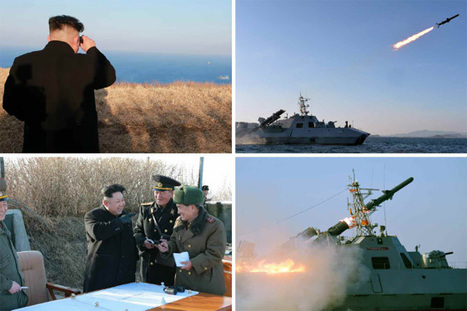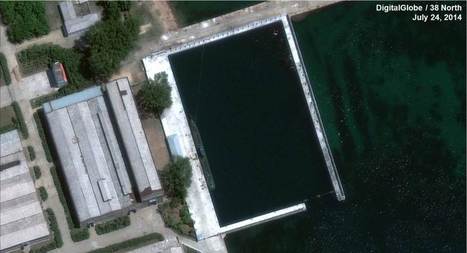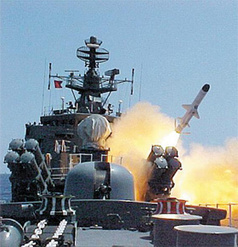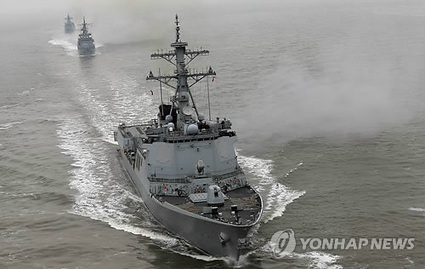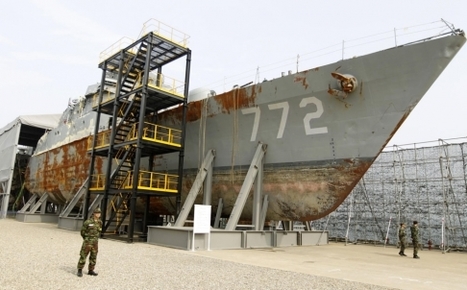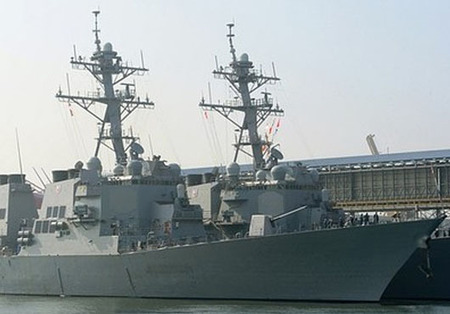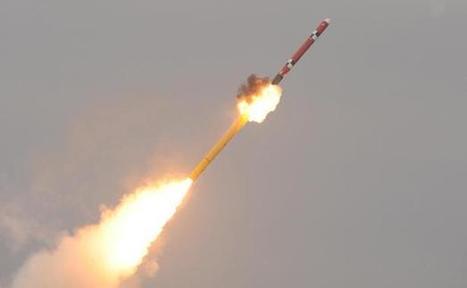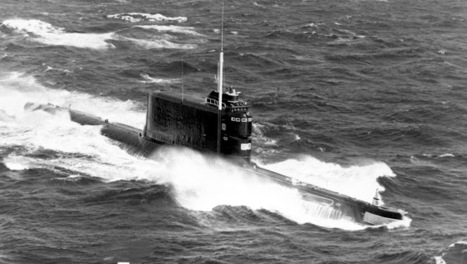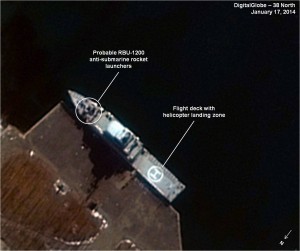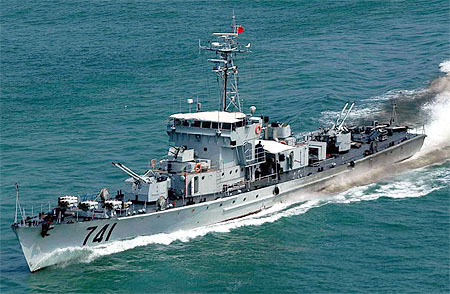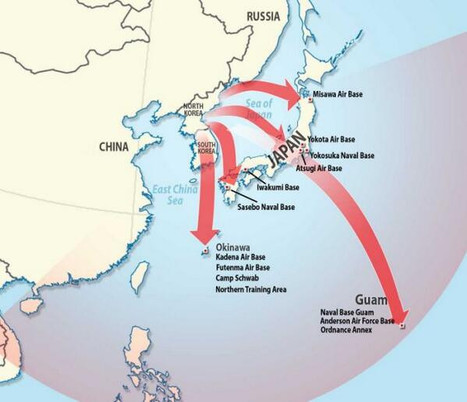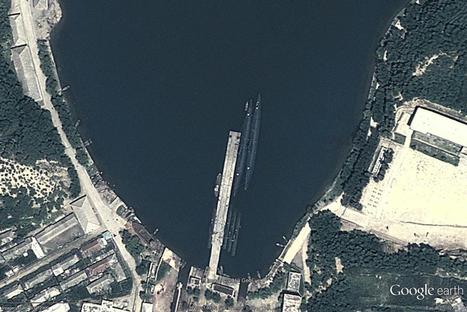 Your new post is loading...

|
Scooped by
Patrick H.
February 8, 2015 6:25 AM
|
SEOUL, South Korea — North Korea said Saturday that it has test-fired a new anti-ship cruise missile, a move experts in Seoul viewed as an attempt to raise tensions ahead of joint military drills between the United States and South Korea.
North Korean leader Kim Jong Un was on-site to observe the successful testing of the “ultra-precision” rocket conducted by the country’s East Sea fleet, the North’s official Korean Central News Agency said. The official Rodong Sinmun newspaper published front-page photos of Kim watching a missile being fired off a naval vessel, although the state media outlets did not mention the time or location of the exercise.
Yang Uk, a Seoul-based security expert and an adviser to South Korea’s navy, said the North Korean missile looked similar to Russia’s KH-35 anti-ship missile, which has a range of about 130-140 kilometers (81-87 miles) and is capable of traveling at high speeds while staying close to the sea’s surface.
North Korea began importing KH-35 missiles in the mid-2000s and the test-firing suggests that the country has succeeded in producing missiles of similar design domestically, Yang said.
Yang Moo-jin, a professor at the University of North Korean Studies in Seoul, said North Korea was demonstrating its military capabilities ahead of next month’s annual U.S.-South Korean drills, which Pyongyang says are a rehearsal for an invasion. The U.S. and South Korea have repeatedly said that the war games are defensive in nature, and that they have no intentions of attacking the North.
North Korea told the United States last month that it was willing to impose a temporary moratorium on its nuclear tests if Washington scraps the military drills with South Korea this year, but the allies have refused to cancel the exercises.

|
Scooped by
Patrick H.
October 22, 2014 7:52 AM
|
La marine nord-coréenne d’un nouveau type de sous-marin. La question est posée par un think tank américain qui s’appuie sur des photos satellites. Le renseignement géospatial se nourrit à la fois d’images des satellites militaires et commerciaux. En l’occurence, c’est une image d’un satellite commercial qui a permis d’identifier ce submersible dans une base navale dans le nord-est de la Corée du Nord. D’après le site 38 North spécialisé sur les questions nord-coréennes, cela ne fait même aucun doute. Il s’agirait ainsi d’un sous-marin de la classe Sinpo d’une longueur de 67 mètres et pouvant représenter une charge utile de 1500 tonnes maximum. La photographie en question a été prise en juillet 2014, le submersibles aurait depuis effectué des patrouilles sous-marines. L’origine du sous-marin demeure mystérieuse. Même si la Corée du Nord a en grande partie bénéficié d’un soutien russe pour constituer sa flotte de submersibles dérivés des Kilos en service dans la marine russe, plusieurs observateurs notent que ce sous-marin semble bénéficier de plusieurs modifications laissant penser que des ingénieurs ont opéré des changements sur ce nouveau sous-marin.

|
Scooped by
Patrick H.
June 10, 2014 4:02 AM
|
North Korea has a new anti-ship missile with a range of 130 km that poses a big threat to South Korea's elderly patrol corvettes.
A recent propaganda film shown on North Korean state TV shows the missile is similar to the U.S.' Harpoon missile, a military source here said Sunday. "It's probably either the Russian-developed Kh-35 Uran or a copy."
The missile was shown among the country's closely guarded submarines, which were also featured for the first time.
The Kh-35 was developed in Russia in the mid-90s and has been exported to Burma, India and Vietnam. It is hard to intercept as it flies 4 to 15 m above the waters.
South Korea's Aegis and other newer destroyers are equipped with rapid-fire machine guns and electronic warfare systems that can intercept or disturb such a missile. But older patrol corvettes or escort ships, whose duties lie mainly near the Northern Limit Line, the de facto maritime border, have no such weapons so the missiles could pose a significant threat to them.
Until recently, the North Korean Navy had only the Styx missile, which was developed in the 50s with a range of 46 km, rising to 80 km in the improved version, and that is vulnerable to electronic jamming.
Military authorities here are reportedly trying to find out where the North bought the Kh-35 missiles, on the assumption that it was clandestinely imported from a third country like Burma.

|
Scooped by
Patrick H.
March 23, 2014 12:17 PM
|
PYEONGTAEK, Corée du Sud, 23 mars (Yonhap) -- La marine sud-coréenne a renforcé les capacités de défense de ses navires de guerre pour mieux pouvoir répondre aux menaces posées par la Corée du Nord, après le torpillage de la corvette Cheonan il y a quatre ans. La corvette de 1.200 tonnes le Cheonan avait coulé en mer Jaune dans la nuit du 26 mars 2010, tuant 46 membres d’équipage. L’enquête sud-coréenne avait déterminé que le navire a été torpillé par la Corée du Nord. Pyongyang a nié être à l’origine de l’attaque. Ce drame a mis en évidence le danger que posent les attaques de la Corée du Nord, danger confirmé quelques mois plus tard par le pilonnage de l’artillerie nord-coréenne sur l’île Yeonpyeong, qui avait fait quatre morts, deux soldats et deux civils. L’Institut de recherche pour la sécurité des affaires nationales a identifié une éventuelle provocation nord-coréenne près de la frontière maritime occidentale comme l’un des trois plus grands risques liés à la sécurité pour la Corée du Sud cette année. Deux affrontements maritimes meurtriers ont déjà eu lieu près de cette frontière, en 1999 et en 2002. «La Corée du Nord pourrait attaquer gratuitement un navire sud-coréen au sud de la frontière maritime pour se venger des escarmouches navales passées, faisant de cette frontière un lieu sensible», a déclaré l’institut dans un récent rapport sur la situation sécuritaire. La Corée du Sud a renforcé ses capacités de défense le long de la frontière maritime occidentale en déployant plus de sous-marins, de navires et d’armes anti-torpilles dans la zone et en renforçant son artillerie dans les îles frontalières. Les navires de guerre et sous-marins ont été en outre équipés ces dernières années de missiles de croisière d’une portée de plus de 1.000km. Quinze destroyers équipés de missiles guidés et de sonars avancés ont été déployés en mer Jaune et en mer de l’Est et vingt nouveaux navires viendront remplacer les navires de patrouille existants dans les dix prochaines années. La Corée du Nord a récemment mis au point un nouveau type de navire de débarquement destiné, selon les autorités sud-coréennes, à rapidement prendre possession des îles sud-coréennes en cas de guerre. Le pays possède de plus environ 70 aéroglisseurs sur sa côte ouest et 60 navires amphibies sur sa côte est, prêts à être utilisés. Pyongyang a aussi mis au point de nouveaux navires de guerre de 200 tonnes équipés de canons de plus gros calibre qu’auparavant et ajoute chaque année à sa flotte de 70 sous-marins un ou deux sous-marins de poche. Le besoin de renforcer les capacités navales du pays est d’autant plus pressant que la Chine et le Japon revendiquent de plus en plus agressivement leur territoire en mer de Chine orientale. La Corée du Sud a mené mercredi un exercice naval de grande envergure en mer Jaune à l’approche du quatrième anniversaire du torpillage du Cheonan, auquel ont participé le destroyer King Sejong the Great de 7.700 tonnes équipé du système Aegis, des navires d’escorte, plusieurs autre navires et un hélicoptère Lynx.

|
Scooped by
Patrick H.
September 8, 2013 6:06 AM
|
A South Korean court yesterday rejected an attempt to ban a documentary film which questions Seoul's claim that North Korea was behind the 2010 sinking of the warship Cheonan. The corvette sank with the loss of 46 lives on the night of March 26, 2010, near the South's disputed Yellow Sea border with the North. An investigation by a South Korean-led international commission concluded it had been sunk by a torpedo from a North Korean submarine - a charge Pyongyang angrily denied. The film highlights theories that cast doubt on the commission's findings. It cites experts who question the findings of the investigation, including one who suggested the warship probably sank after colliding with a submarine of unknown origin. Project Cheonan angered the military, and three naval officials - together with two relatives of sailors who died on the Cheonan - filed an injunction last month to ban the documentary. But the court at Uijeongbu near Seoul rejected the injunction, saying the movie had not distorted facts or tarnished the reputation of the victims as claimed by the complainants.

|
Scooped by
Patrick H.
May 13, 2013 2:36 AM
|
The U.S. nuclear-powered aircraft carrier arrives to participate in joint naval drills as part of routine training according to the Combined Forces Command. The 97,000-ton Nimitz, one of the world's largest warships, made a port call at the southeastern port city of Busan for a three-day stay to participate in joint military drills in southern and eastern waters of the Korean Peninsula.
Carrier Strike Group (CSG) 11 is comprised of the aircraft carrier USS Nimitz (CVN 68) along with embarked Carrier Air Wing 11, Arleigh Burke-class guided-missile destroyer USS Preble (DDG 88) and Ticonderoga-class guided-missile cruisers USS Princeton (CG 59) and USS Chosin (CG 65). This year marks the 60th anniversary of the bond between the two nations, a bond Rear Adm. Michael White, commander, CSG 11, said has only strengthened with time. "It is always a pleasure when we have the opportunity to meet with our allies in the Republic of Korea," said White. "I'm looking forward to deepening the close friendship enjoyed by the Republic of Korea and the United States."

|
Scooped by
Patrick H.
April 11, 2013 2:22 AM
|
A powerful U.S. military sea-based radar is now in place to detect any possible missile launches by North Korea, according to a senior U.S. defense official. "The SBX is in position," the defense official, who spoke on condition of anonymity, told Agence France Presse late Wednesday. The official would not offer more details but confirmed the SBX, a floating X-band radar that resembles a giant golf ball, had reached a location at sea where it could track missiles fired by the Pyongyang regime. U.S. and South Korean forces remain on heightened alert amid expectations North Korea will launch a missile or multiple missiles before the April 15 celebrations for the birthday of the North's late founder, Kim Il-Sung. The United States has already bolstered its missile defenses in the region to help protect allies South Korea and Japan as well as U.S. bases in Guam. Two U.S. Arleigh-class destroyers have been sent to the western Pacific with anti-missile weaponry while ground-based THAAD interceptor batteries had been deployed to Guam, a U.S. territory about 3,380 kilometers (2,100 miles) southeast of North Korea. The U.S. military also staged shows of force as part of drills with South Korea, with over-flights by B-52 and B-2 bombers as well as sophisticated F-22 fighter jets. The floating X-band radar, which sits atop a platform similar to an oil rig, had been stationed at Pearl Harbor in Hawaii. The SBX radar, which is 85 meters (280 feet) tall and operated by civilian contractors, is supposed to detect missile launches over a range of at least 2,000 kilometers. Meanwhile Yonhap news agency reported that North Korea has been repeatedly moving multiple missiles around in an apparent bid to confuse outside intelligence gatherers ahead of an expected launch. According to intelligence analysis cited by the South Korean news agency, two mid-range Musudan missiles have been repeatedly moved in and out of a warehouse facility on its east coast. At the same time, at least five mobile launch vehicles have also been spotted swapping places and positions. "There are signs the North could fire off Musudan missiles any time soon," an intelligence source told Yonhap. "But the North has been repeatedly moving its missiles in and out of a shed, which needs close monitoring." Another source suggested Pyongyang was hoping to "fatigue" South Korean and U.S. intelligence gatherers.

|
Scooped by
Patrick H.
April 6, 2013 3:48 PM
|
Où peuvent frapper les missiles nord-coréens

|
Scooped by
Patrick H.
April 6, 2013 3:45 PM
|
Sites stratégiques Corée du Nord

|
Scooped by
Patrick H.
April 5, 2013 4:01 PM
|
South Korea has dispatched two destroyers to watch both sides of the peninsula for a possible North Korean missile launch, South Korean media report. According to a South Korea Navy official quoted by Yonhap news agency, the destroyers were outfitted with SPY-1 radar which can track hundreds of objects simultaneously from up to 1,000 kilometres away. At the same time, the American Department of Defense is going to deploy Terminal High Altitude Area Defense System, or THAAD, ballistic missile defense system to Guam in the coming weeks as a precautionary move to strengthen the regional defense posture against the North Korean regional ballistic missile threat, Pentagon officials said on Wednesday, 3th April. Several media reports indicated that a KN-08 missile was positioned to the east coast of North Korea on Thursday. The KN-08 missile could reach “a considerable distance”, including Japan, South Korea and U.S. military bases on the Pacific Island of Guam. “The United States continues to urge the North Korean leadership to cease provocative threats and choose the path of peace by complying with its international obligations, remains vigilant in the face of North Korean provocations, and stands ready to defend U.S. territory, allies and national interests”, the Pentagon statement read. The move of rockets was condemned by the European Union, the United Nations, the U.S., Russia and by China

|
Scooped by
Patrick H.
April 2, 2013 5:51 AM
|
According to a Pentagon official, the US Navy deployed one of its Destroyers off the Korean Peninsula amid growing tensions with North Korea. USS Fitzgerald, who had sailed to South Korea recently to participate in joint military exercises, was sent to the south-west peninsula instead of returning to its home port in Japan, the official said, who wished to remained unnamed. This deployment is a cautious initiative that can offer "more options for missile defense if the need arises," the source added. USS Fitzgerald (DDG-62) is a is an Arleigh Burke-class (DDG-51) Flight I destroyer. It is capable to launch Raytheon's SM-3 missiles.
The SM-3 is a defensive weapon used by the U.S. Navy to destroy short- to intermediate-range ballistic missiles. The SM-3 destroys incoming ballistic missile threats by colliding with them, a concept sometimes described as “hitting a bullet with a bullet.” The impact is the equivalent of a 10-ton truck traveling at 600 mph.
DDG 51 multi-mission guided missile destroyers operate in support of carrier battle groups, surface action groups, amphibious groups and replenishment groups, providing a complete array of anti-submarine, anti-air and anti-surface capabilities. Designed for survivability, the ships incorporate all-steel construction and have gas turbine propulsion. The combination of the ships’ Aegis combat system, the vertical launching system, an advanced anti-submarine warfare system, two embarked SH-60 helicopters, advanced anti-aircraft missiles and Tomahawk anti-ship and land-attack missiles make the Arleigh Burke class one of the most powerful surface combatant ever put to sea.

|
Scooped by
Patrick H.
February 14, 2013 10:41 AM
|
La Corée du Sud a présenté ce jeudi un nouveau missile de croisière capable, selon elle, d'atteindre les bureaux des dirigeants nord-coréens. Les responsables sud-coréens ont cependant refusé de préciser la portée exacte de ce missile, se contentant d'affirmer qu'il pouvait atteindre l'ensemble du territoire de la Corée du Nord. «Le missile de croisière dévoilé aujourd'hui est une arme de précision capable de repérer et de frapper la fenêtre des bureaux des dirigeants nord-coréens», a déclaré le porte-parole du ministère de la Défense, Kim Min-seok. Le retard technologique nord-coréen démenti La Corée du Sud s'emploie à démentir l'impression d'un retard technologique vis-à-vis de la Corée du Nord, qui a procédé mardi à un troisième essai nucléaire. Le régime nord-coréen a aussi placé un satellite en orbite en décembre. Les Etats-Unis, alliés de la Corée du Sud, pensent que l'objectif final du régime communiste nord-coréen est de se doter de missiles intercontinentaux capables de transporter des ogives nucléaires afin de menacer le territoire américain. La Corée du Sud et la Corée du Nord sont toujours techniquement en guerre, seule une trêve ayant mis fin aux hostilités de la période 1950-1953. L'essai nucléaire nord-coréen attise les tensions sur la péninsule coréenne à l'approche de l'investiture, prévue le 25 février, de la nouvelle présidente sud-coréenne, Park Geun-hye. «La situation présente sur la péninsule coréenne est si grave que même un infime incident peut conduire à une guerre ouverte susceptible de perturber l'ensemble de la région», a rapporté l'agence de presse officielle nord-coréenne KCNA.

|
Scooped by
Patrick H.
February 4, 2013 8:07 AM
|
SEOUL, Feb. 4 (Yonhap) -- South Korea and the United States on Monday began a joint naval drill along the eastern coast, military officials said, sending what appears to be a warning to North Korea as it threatens to conduct a third nuclear test.
The three-day exercise kicked off earlier in the day in the East Sea to test the combat readiness of the two allies, in an apparent effort to give a warning to North Korea ahead of its possible nuclear test in the northeastern tip of the country. Two U.S. ships equipped with long-range cruise missiles -- the USS San Francisco, a 6,800-ton nuclear submarine, and the 9,800-ton Aegis cruiser Shilo -- were mobilized for the exercise held near the eastern port city of Pohang.
The South Korean Navy deployed 10 vessels, including one 7,600-ton Aegis destroyer, a corvette and its newest Type-214 submarines as well as anti-submarine and maritime surveillance aircrafts and maritime helicopters.
"Naval forces of South Korea and the United States started to carry out drills in the East Sea," an official at the Joint Chiefs of Staff said. "The exercise involves naval maneuvers, submarine detection, live-fire drills and anti-ballistic missile drills."
Gen. Jung Seung-jo, the JCS Chairman, last Friday said the joint drill aims to guard against possible North Korean provocations involving submarines.
North Korea has a large fleet of submarines, and one of them is suspected to have torpedoed a South Korean Navy warship in the Yellow Sea in March 2010 killing 46 sailors.
The latest move comes after Pyongyang has threatened to carry out its third nuclear test in response to United Nations Security Council sanctions imposed for its December long-range rocket launch.
On Sunday, the North's state media said Kim Jong-un made an "important" decision regarding the communist state's security and sovereignty, fueling expectations for an imminent nuclear test.
South Korean and American intelligence officials have been analyzing daily updates from satellite imagery of the Punggye-ri site, where one of three tunnels has been recently covered with a camouflage net in an attempt to foil their efforts to detect early signs of a nuclear test.
Earthquake monitoring stations and military officials have been on standby to detect seismic tremors and measure increased radiation in the air in case of a detonation.
|

|
Scooped by
Patrick H.
November 2, 2014 5:37 AM
|
Summary Recent press reports have raised the possibility that North Korea is developing the capability to launch ballistic missiles from submarines.[1] A review of commercial satellite imagery since 2010 covering submarine bases and submarine shipyards has identified a new test stand at the North’s Sinpo South Shipyard, probably intended to explore the possibility of launching ballistic missiles from submarines or of a shipboard vertical launch ballistic missile capability. The new installation is the right size and design to be used for the research, development, and testing of the process of ejecting a missile out of a launch tube as well as evaluating its compatibility with submarines and surface combatants as well as the missiles themselves. While the potential threat from a future North Korean capability to launch ballistic missiles from submarines should not be ignored, it should also not be exaggerated. If the North decides to pursue such a capability, it is likely to take years to design, develop, manufacture, and deploy an operational submarine-launched ballistic missile (SLBM) force. While the development of submarines carrying ballistic missiles could provide North Korea with a survivable second-strike nuclear capability, aside from the technological challenge, it also assumes that Pyongyang would entrust an operational nuclear-armed missile to the captain of a submarine who would, in time of war, most likely be out of communication with the leadership. Exactly what missile system would be utilized is purely speculative at this point in time. North Korea’s capabilities would be stretched to their limit if it used a large liquid-fuelled system such as a naval version of the Musudan intermediate-range or Nodong medium-range ballistic missile. A naval version of the liquid-fuelled Scud, solid-fueled short-range ballistic missiles like its current KN-02 model, or an entirely new system would likely present less of an engineering challenge. Alternately, if North Korea could access vertical or torpedo-launched cruise missile technology, these might present the easiest and fastest routes to a submarine launch missile capability. Lire l'intégralité de l'article sur 38 North : http://38north.org/2014/10/jbermudez102814/

|
Scooped by
Patrick H.
September 14, 2014 12:07 PM
|
South Korea's military confirmed Sunday it has detected signs of North Korea's development of a submarine-based ballistic missile launch system.
In a report to an opposition lawmaker, the Joint Chiefs of Staff (JCS) said there is an indication that the North is developing a submarine-launched ballistic missile (SLBM).
"There is no intelligence yet that North Korea has an SLBM in operation. But the possibility of a North Korean submarine equipped with an SLBM has been detected recently," the JCS said in the document submitted to Rep. Jin Sung-joon of the main opposition New Politics Alliance for Democracy.
South Korea and the U.S. are jointly scrutinizing the North's related move, added the JCS.
A senior South Korean government source also said the South Korean and U.S. intelligence agencies spotted signs that the North has developed a ballistic missile launch tube.
"A missile launch tube for submarine use has been spotted, which appears to have been developed at North Korea's submarine base," the source said on condition of anonymity.
Chances are high that the North will test-fire a SLBM in the foreseeable future, and if it is successful, the communist nation is expected to seek to acquire larger submarines, according to the source.
An annual white paper on warships, Jane's Fighting Ships, said in its 1994 edition that North Korea purchased 40 decommissioned submarines from Russia, including several Golf-class and Romeo-class submarines.
The North has reportedly deployed more than 20 Romeo-class submarines, which are not capable of carrying an SLBM launcher.
It may be modifying 3,000-ton Golf-class submarines for SLBMs, the source said.
In August, a U.S. web magazine, the Washington Free Beacon, quoting unnamed U.S. defense officials, said the U.S. intelligence community has identified at least one North Korean submarine equipped with a ballistic missile launch tube. (Yonhap)

|
Scooped by
Patrick H.
May 16, 2014 3:22 AM
|
Summary Recently, commercial satellite imagery has identified two new North Korean helicopter carrying frigates. These are the largest surface combatants constructed by the DPRK’s Korean People’s Navy (KPN) in 25 years and appear to be primarily designed to counter what Pyongyang sees as a growing threat from South Korea’s acquisition of submarines that began in the early 1990s. Moreover, these vessels may have an important secondary role: the protection of fisheries in the West and East Seas, which has obvious important security implications for the Republic of Korea, Japan and China. Their introduction into the North Korean fleet may also represent an evolutionary step in the development of naval strategy to include helicopter anti-submarine operations. Construction began in 2006-07 and both ships were launched during 2011-12. However, it is unclear whether they have been commissioned and are ready for service. Nevertheless, should the KPN push aggressively to commission and operate these new vessels, it will still likely take several years to fully integrate their new capabilities into fleet operations. The construction of these vessels and other new classes of naval combatants over the past decade has been achieved during a period of prolonged and expanding international economic sanctions against North Korea as well as almost weekly media reports of its military decline, and national economic and industrial stagnation. North Korea’s deployment of new helicopter frigates may be an important wakeup call not only about the overall effectiveness of sanctions in constraining Pyongyang’s conventional military programs, but also the need to carefully and realistically reevaluate reports of its conventional military decline.... Estimated Characteristics, new North Korean FFH Length76 m Beam11 m Displacement1,300 tonnes Draught3.4m Armament : 4 x RBU 1200 ASW rocket launchers
1(?) x 30mm CIWSHelicopter1 x Mi-4PL or Mi-14PL

|
Scooped by
Patrick H.
November 5, 2013 2:26 AM
|
SEOUL — A number of North Korean sailors were killed when a warship sank during “combat duties” last month, a state newspaper has reported in an unusual admission by the secretive state. The North’s ruling party newspaper Rodong Sinmun gave no figures for the number of dead. But photographs of gravestones in Saturday’s website edition suggested about 15-20 may have died. The paper showed solemn-faced leader Kim Jong-Un laying flowers at a cemetery specially created for victims of the incident, who “met heroic deaths while performing their combat duties”. The report gave no details of how the sailors on a ship identified as “submarine chaser no. 233” had died. It did not say where the cemetery was located. After hearing of the incident, Kim ordered a search to retrieve all the bodies and gave detailed instructions on construction of the cemetery and gravestones, the paper said. South Korea’s Chosun Ilbo newspaper said Monday that two North Korean warships sank last month during an exercise off the eastern port of Wonsan, killing scores of sailors. Quoting a military source, it said the ships were a Hainan-class 375-ton submarine chaser and a 100 to 200-ton patrol boat. “The Hainan-class submarine chaser probably sank because it’s old. It was built in China in the 1960s and the North bought it in the mid-70s,” the source was quoted as saying. North and South Korea have remained technically at war since the Korean conflict ended in an armistice in 1953. While the North’s military totals more than one million personnel, much of its equipment is aging. Seoul accused Pyongyang of sending a submarine to sink a South Korean warship in March 2010 with the loss of 46 lives.

|
Scooped by
Patrick H.
September 2, 2013 3:04 AM
|
Panama says an undeclared Cuban weapons cargo found on a North Korean ship is an "undoubted violation" of the United Nations' arms embargo on Pyongyang. A draft report by UN experts sent to Panama after the seizure of the ship in July confirmed a breach of sanctions, the ministry of public security said. Two North Korean diplomats are in Panama to assist the ship's 35 crew. Cuba said it shipped the arms to North Korea for repair. It did not say why they were hidden under tonnes of sugar. A source in the public security ministry said authorities had been given a first draft of the report compiled by UN sanctions panel experts, the AFP news agency reports. The ship, the Chong Chon Gang, was seized on suspicion it was carrying drugs. The vessel had been navigating the Panama Canal. Officials found 25 containers of military hardware, including two Soviet-era MiG-21 fighter aircraft, air defence systems, missiles and command and control vehicles. The statement from the Panamanian public security ministry was released after the North Korean diplomats - from the country's mission in Havana - visited the crew members at a former military base. Satellite tracking
They are being detained on suspicion of arms trafficking; an offence which carries a 12-year prison sentence. The United Nations inspectors completed their work two weeks ago but are yet to present their official findings publicly. The Chong Chon Gang left Russia's far east on 12 April and travelled across the Pacific Ocean before entering the canal at the start of June, with Cuba as its stated destination. The ship disappeared from satellite tracking systems after it left the Caribbean side of the canal, resurfacing on 11 July. Experts say this may indicate that the crew switched off the system that automatically communicates details of their location. It was stopped near Manzanillo on the Atlantic side of the canal on 15 July. Under United Nations sanctions, North Korea is banned from weapons exports and the import of all but small arms.

|
Scooped by
Patrick H.
April 16, 2013 12:04 PM
|
April 16, 2013: North Korea recently imported 660 kg (1,452 pounds) of silver from China, which is a lot of silver ($600,000 worth) for poverty stricken North Korea. A popular interpretation is that the silver is for batteries used on the larger number of an improved version of its Sang-O (Shark) class mini-sub. All the new ones appear to be armed with torpedoes (in two torpedo tubes). North Korean admirals now believe that the Sang-Os could be a decisive weapon against American and South Korean ships. This move was apparently the result of the success in using an older version of Sang-O in 2010 to sink a South Korean corvette. North Korean naval commanders were impressed with the subsequent discussion by South Korean and American navy officials about the difficulty in dealing with such small subs. It appears that North Korea decided to build a lot more of these small subs. The 250 ton Sang-O is actually a coastal sub originally developed for special operations (commando transports). The original design is a 34 meter (105 feet) long boat with a snorkel and a top submerged speed of 17 kilometers an hour (or 13 kilometers an hour when at periscope depth using the snorkel to run the diesel engines). Top surface speed is 13 kilometers an hour. Max diving depth is 150 meters (465 feet) and the boat is designed to rest on the ocean bottom (useful when trying to avoid enemy search). There is a crew of 15, plus space for either six scuba swimmer commandos, or a dozen men who can go ashore in an inflatable boat. Sang-Os have two torpedo tubes, which can also carry mines or just supplies. Some of the early models had no torpedo tubes, enabling them to carry more people or cargo. Max endurance is about eight days. The new model is 39 meters (121 feet) long and is believed to have a max submerged speed of 27 kilometers an hour and several other improvements. Over 50 Songs have been built so far, and one was captured by South Korea when it ran aground in 1996. At least a dozen are of the new model and a dozen or more are apparently under construction. This is one of the few ship building operations underway in North Korea.

|
Scooped by
Patrick H.
April 8, 2013 12:25 PM
|
Japan has ordered its armed forces to shoot down any North Korean missile headed towards its territory, a defence ministry spokesman says. Japan’s Navy operates four Kongo class destroyers equipped with AEGIS-BMD type anti-air and missile systems, and SM-3 Block IA interceptors, capable of defeating ballistic missiles. Japan’s Defence Minister Itsunori Onodera issued the order, which will see these Aegis destroyers deployed in the Sea of Japan, the defence official said. The official said the order, which was issued on Sunday, was routine and was being kept low-key. “We won’t hold press conferences on this order because of Japan’s policy principle that we will not be swayed by North Korean provocations. The order followed intelligence indications about North Korea preparations for testing ballistic missiles soon, tests that could further escalate the tension in the Korean peninsula. The US has already delayed its own missile test because of soaring tensions in Korea. Kim Jang-Soo, chief national security adviser to South Korean President Park Geun-Hye, said a test-launch by the North, or other provocation, could happen any day now, as Western diplomates were orderred to leave Pyongyang before Wednesday, April 10.

|
Scooped by
Patrick H.
April 6, 2013 3:46 PM
|
Corée du Nord : rayon d'action et stock de missiles

|
Scooped by
Patrick H.
April 6, 2013 1:51 AM
|

|
Scooped by
Patrick H.
April 5, 2013 4:11 AM
|
Over the last three years North Korea has significantly stepped up its production of submersible vessels such as midget submarines, according to an inside source. The sinking of the South Korean corvette ‘Cheonan’ in March 2010 by just such a North Korean midget submarine is said to have caused the authorities to appreciate the potential importance of such vessels to their asymmetrical warfare capabilities.
As such, there are suspicions that the recent North Korean decision to import more than 600kg of silver through China was done to facilitate the production of batteries for submersible production.
A North Korean military source told Daily NK on the 4th, “The [North Korean] Navy has been producing submersibles at every shipyard on their east and west coasts ever since the attack on the Cheonan in 2010.”
According to the inside source, prior to the Cheonan sinking such vessels were produced at one shipyard, the disguised ‘Bongdae Boiler Factory’ in Sinpo, South Hamkyung Province, at a rate of five per year. However, following the sinking of the Cheonan that rate went up four times to 16 per year, as the vessels started being produced across multiple shipyards including Yongampo, Chongjin and Rajin.
The source explained, “The reason why the North Korean authorities are increasing production of this kind of submersible that can fire torpedoes is to maximize their underwater attack capacity. The subs can take 12 to 15 soldiers yet still sink destroyers weighing thousands of tons with their twin torpedoes.”
“The engines noise on the submersibles is very quiet, making them able to approach their targets underwater in secret, while it is impossible to trace crimes such as the Cheonan incident,” the source went on, adding that during North Korean military training exercises they also emphasize the essential nature of the subs.
The rising production is pushing up demand for batteries, the source then went on to add, saying that this required the bulk production of both silver and zinc. “All the silver produced in North Korea is supplied to the shipyards,” he claimed.
The source admitted to being confused, therefore, at North Korea’s recent decision to import 660kg of silver from China, declaring, “There is lots of silver being produced in North Korea, so it’s hard to say why they are importing it from China…I suppose it may have been just that more batteries were being produced so they needed more silver.”

|
Scooped by
Patrick H.
March 7, 2013 3:18 AM
|
By Kim Eun-jung
SEOUL, March 6 (Yonhap) -- North Korea has started submarine drills and stepped up preparations for nationwide military exercises, which may be timed to coincide with annual joint drills by South Korea and the United States set to start next week, military sources said Wednesday.
The latest move comes as Pyongyang has ratcheted up its hostile rhetoric against Seoul and Washington as the two allies last week launched a two-month field training exercise called Foal Eagle. Separately, joint forces will conduct computer-simulated drills named Key Resolve from March 11 to 21.
On Tuesday, Pyongyang threatened to scrap the 1953 armistice that ended the Korean War, citing tensions over South Korean-U.S. joint military exercises and the United Nations' move to impose sanctions for its Feb. 12 nuclear test.
A statement by the North's military said the armistice will be "completely" nullified from March 11, when Key Resolve gets into full swing in the South, warning a "precise" strike at any time. "North Korea's submarines have entered military maneuvers in the Yellow Sea and East Sea," a military source said, on the condition of anonymity. "This year's winter drill was more intense than in the past years and artillery exercises tripled."
When President Park Geun-hye was sworn into office on Feb. 25, North Korea's artillery unit carried out firearm training targeting the South Korean capital Seoul, he said.
The North will start large-scale drills across the nation from next week when South Korean and the U.S. troops start the two-week war game, another military source said, asking for anonymity.
A large-scale firearm drill will be held near the east coastal city of Wonsan, while nationwide military maneuvers will be carried out, the source said.
According to multiple military sources, the North has recently declared a "no-fly zone" in the west and the east of the Korean Peninsula during the May 11-20 Key Resolve training period, fueling speculation that it may fire off missiles. Seoul's defense ministry declined to comment.
In the past, Pyongyang had declared no-fly zones before it fired short-range missiles or conducted maritime firing drills.
"As (North Korea's) army, navy and air force are preparing a large-scale firearm training near Wonsan, the no-fly zone may be aimed at maritime or air firing drills," a third source said. "But we don't exclude a possibility of a missile launch."
In response to the North's latest military movement, South Korea has stepped up its military readiness and surveillance to counter any North Korean provocations during the training period, the Joint Chiefs of Staff (JCS) said.

|
Scooped by
Patrick H.
February 7, 2013 2:58 AM
|
Earlier today I posted a blog about the release of satellite imagery about North Korea’s naval bases. In going through the imagery, I discovered that the author of the original piece on cryptome.org missed the North Korean navy’s two most important facilities - the heavily protected submarine bases on the island of Mayang-do at the village of Mayangdori (40.0 N 128-10-36E); and the second sub base which located outside the coastal village of Chahonodongjagu, a/k/a Ch’aho (40-12-56N 128-38-39E). Both bases are situated on the east coast of North Korea. ... Most of these subs are clearly visible in currently available Google Earth satellite imagery. For example, look at this cluster of four Romeo-class subs sharing the same berth at the Mayang-do sub base. If you look just to the south of this berth, you will see two more subs, one of which possibly a Romeo-class sub, docked at the base. About 1,000-meters to the southwest is another heavily protected dock complex housing another cluster of four Romeo-class submarines and possibly two of the smaller Sango-class subs.
|




 Your new post is loading...
Your new post is loading...
